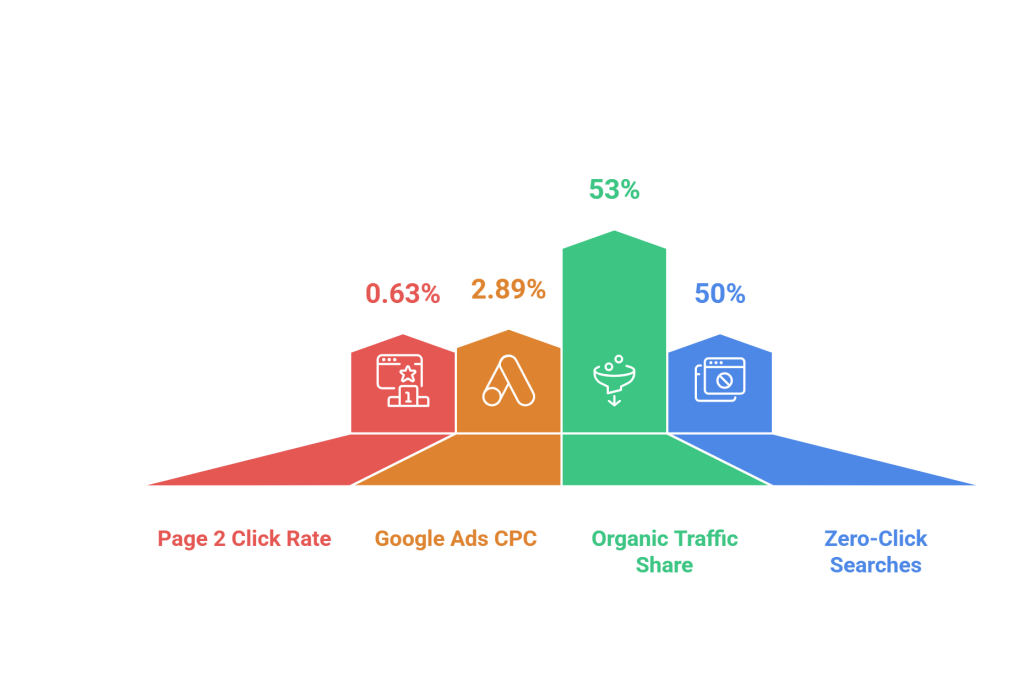Are you investing in SEO and content marketing but still buried on page two (or worse)?
You’re not alone, and it’s costing you more than you think.
The Harsh Reality: Why Most Websites Never Rank on Google
In 2025, ranking high on Google is more than a goal; it’s a necessity. Yet, many U.S. businesses are investing thousands in digital marketing without ever reaching the first page of search results. Why?
Most agencies are either using outdated SEO practices or applying cookie-cutter solutions that simply don’t work anymore.
Here are the hard facts:
- Only 0.63% of searchers ever click on a result from page 2.
- Google Ads CPCs are rising, averaging $2.89 across industries.
- 53% of total web traffic comes from organic search—you miss out if you’re not ranking.
- Zero-click searches now make up more than 50% of all Google searches, making it even harder to get organic clicks if you’re not optimized smartly.

The bottom line:
If your business isn’t ranking on the first page, preferably in the top 3 results, you’re invisible to your potential customers. That invisibility leads to higher ad spend, lower lead volume, and reduced brand trust.
The Real-World Consequences of Poor Google Rankings
Failing to appear in top search results can lead to:
- Missed sales opportunities
- Rising cost per acquisition (CPA)
- Reduced organic reach and engagement
- Dependence on paid ads without sustainable ROI
These are not just SEO problems—they’re business problems. So, let’s fix them.
7 Proven Strategies to Skyrocket Your Google Rankings in 2025
Below are advanced, yet practical strategies that go beyond the basics. These are the same techniques we apply for clients who turn struggling websites into powerful lead-generation machines.
1. Match Content to Search Intent (Not Just Keywords)

Google now ranks pages based on how well they satisfy search intent, not just keyword usage. This means it’s not enough to stuff keywords onto a page. Your content needs to give users exactly what they’re looking for, in the format they expect.
When your content aligns with the reason behind a search—whether it’s to learn, compare, buy, or find something—Google sees it as more useful and ranks it higher.
Tip:
For every target keyword, ask:
Is the searcher looking for information, a product, a solution, or a comparison?
Then, structure your page to deliver that answer clearly and quickly, preferably in the first few paragraphs.
Example:
Let’s say you’re targeting the keyword: “best CRM for small businesses.”
- Search Intent: Commercial Investigation (the user is comparing options and may be close to buying)
- Wrong Approach: A generic blog titled “What is a CRM?”
- Right Approach: A comparison-style blog like:
Top 7 CRMs for Small Businesses in 2025 (With Pros, Cons & Pricing)
This satisfies the intent by:
- Listing multiple CRM tools
- Providing side-by-side comparisons
- Including use cases and pricing
- Recommending based on business type (e.g., solo entrepreneur vs. small team)
Add a quick summary table or “best for” recommendation block at the top of the post to grab scanners’ attention.
2. Build Topical Authority with Content Silos

Google no longer favors websites that post a random mix of articles. Instead, it rewards topical authority sites that go deep and wide into a subject, showing they’re an expert on the topic.
This is where content silos come in.
A content silo is a structure where you organize your content around a central topic (pillar) and interlink it with detailed subtopics (cluster articles). This helps:
- Users navigate your site easily
- Search engines understand the depth of your expertise
- Pages pass internal link authority to each other, boosting rankings
Tip:
Choose a core topic (pillar page) and then create 8–12 supporting articles that dive into specific aspects of that topic. Link them all together to create a tightly connected knowledge hub.
Let’s say you’re targeting the keyword: “Digital Marketing for Kitchen Remodeling Businesses”
This becomes your pillar page—a comprehensive guide that walks kitchen remodeling companies through how to generate leads and increase bookings using online marketing.
Now, create supporting content (cluster articles) like:
- Local SEO for Kitchen Remodelers: Get Found by Homeowners in Your Area
- Google Ads Strategies for Home Renovation Services
- Optimizing Your Kitchen Remodeling Website for Conversions
- How to Use Before/After Galleries to Attract New Clients
- Facebook and Instagram Ads for Home Renovation Leads
Each of these subtopics links back to the Digital Marketing for Kitchen Remodeling Businesses pillar page. The pillar summarizes and links to each one, forming a structured and interconnected content hub.
3. Use Semantic SEO and NLP Terms to Match Google’s Understanding

Google’s algorithms, like BERT and MUM, have changed how content is understood. They no longer just match keywords—they interpret context, relationships between terms, and search intent. That’s where Semantic SEO and NLP (Natural Language Processing) come into play.
Instead of relying on exact-match keywords, aim to include related concepts, entities, and phrases that support the main topic. Tools like SurferSEO, Clearscope, or MarketMuse can help you identify these NLP-friendly terms.
Example:
If your target keyword is “Digital Marketing for Dentists”, your content shouldn’t just repeat that phrase. Instead, include related terms such as:
- Local SEO for dental clinics
- HIPAA-compliant marketing strategies
- Google Business Profile optimization
- Patient appointment systems
- Reputation management for dentists
Using these naturally within your content tells Google you’re covering the topic in depth, which can boost topical authority and improve your rankings.
4. Crush Your Core Web Vitals

Google now treats page experience as a direct ranking factor, and your Core Web Vitals play a key role in that. These metrics focus on how fast your page loads, how quickly users can interact with it, and how visually stable it is while loading.
The three key metrics to optimize:
- Largest Contentful Paint (LCP) – Measures loading performance
- Interaction to Next Paint (INP) – Replaces First Input Delay (FID), measuring responsiveness
- Cumulative Layout Shift (CLS) – Tracks visual stability during load
Poor scores on these can lead to lower rankings, even if your content is great.
Tip:
Use tools like PageSpeed Insights to analyze your site’s performance. Then:
- Compress and serve images in next-gen formats (like WebP)
- Minimize unused JavaScript and CSS
- Use a Content Delivery Network (CDN) to improve load times globally
- Set proper image dimensions to avoid layout shifts
Example:
If your blog’s featured image is too large and loads slowly, it will hurt your LCP score. Compressing it with tools like TinyPNG and lazy-loading it can make a noticeable difference in both performance and rankings.
By nailing your Core Web Vitals, you not only please Google, you also keep visitors engaged and reduce bounce rates.
5. Win the Zero-Click Game (Featured Snippets + FAQs)

Over 50% of Google searches now end without a single click. Why?
Because users are getting their answers directly from the search results page, through featured snippets, People Also Ask boxes, and FAQ-rich results.
Instead of seeing this as lost traffic, treat it as a chance to gain more visibility and build authority right in the SERP.
Tip:
To increase your chances of showing up in featured snippets and zero-click positions:
- Use Q&A formats naturally within your content
- Provide concise, direct answers (ideally 40–60 words) immediately after the question
- Format content using bullet points, numbered lists, or short paragraphs
- Implement the FAQ schema using structured data markup to enhance your chances of showing in rich results
Example:
If your blog covers “How to Market a Local Dental Clinic,” include a question like:
Q: What is the best way to promote a local dental clinic?
A: Start by optimizing your Google Business Profile, collecting patient reviews, and running local search ads. Combine this with a mobile-friendly website and localized SEO content to attract nearby patients.
By doing this, you’re not only helping readers, you’re giving Google a snippet-worthy answer.
6. Engineer Internal Linking Like a Pro

Internal linking isn’t just about navigation—it’s a powerful SEO strategy that helps distribute page authority and clarify topic relationships to search engines.
When done right, internal links can:
- Improve crawlability and indexing
- Boost the rankings of underperforming pages
- Guide users to deeper content on your site
Tip:
Link from high-traffic, authoritative pages to newer or lower-performing pages within the same content cluster. This passes link equity while also signaling relevance.
Use descriptive anchor text—avoid “click here.” Instead, anchor phrases that include target keywords or semantic variations.
Example:
If your blog on “Digital Marketing for Dentists” is performing well, you can link from it to a newer post like “How to Set Up HIPAA-Compliant Email Marketing” using anchor text such as:
“Learn how to create HIPAA-compliant email campaigns to protect patient data while marketing effectively.”
This not only supports SEO but also enhances user engagement by guiding readers to more specific, valuable content.
7. Showcase E-E-A-T: Experience, Expertise, Authoritativeness, Trust

Google increasingly evaluates content through the lens of E-E-A-T—Experience, Expertise, Authoritativeness, and Trustworthiness. This is especially crucial in YMYL (Your Money, Your Life) niches like finance, healthcare, and legal, where poor information can impact someone’s well-being or finances.
To rank well, your content must not only be helpful but also credibly created and trustworthy.
Tip:
Strengthen your E-E-A-T signals by:
- Displaying author bios with relevant credentials or experience
- Citing reputable sources (government sites, industry publications)
- Embedding video testimonials or client feedback to prove real-world results
- Showcasing trust symbols like security badges, certifications, media mentions, or industry affiliations
- Publishing case studies that include data, outcomes, and direct quotes
Example:
If you’re writing a guide on “Digital Marketing for Medical Practices,” boost trust by:
- Listing the author’s credentials in healthcare marketing
- Quoting HIPAA guidelines directly from official sources
- Embedding a testimonial video from a clinic owner
- Linking to a published case study showing campaign results with patient growth metrics
This not only satisfies Google, it gives readers confidence in your content.
Stop Doing These (Now Outdated) SEO Practices
- Keyword stuffing
- Buying spammy backlinks
- Writing content without user value
- Ignoring mobile UX
- Publishing without a content strategy
Rankings Aren’t Just an SEO Issue—They’re a Business Growth Opportunity
If your website is buried deep in Google’s search results, you’re not just losing visibility, you’re losing leads, trust, and revenue. The strategies outlined above aren’t SEO “hacks.” They’re sustainable, Google-aligned tactics that reflect how search works in 2025.
SEO success now requires more than keywords and backlinks. It’s about content depth, technical performance, user trust, and strategic execution.
Ready to Rank Like a Market Leader?
Whether you’re a local service provider or a national brand, we can help you build and execute a 90-day SEO roadmap that delivers measurable results, more visibility, more traffic, and real ROI.
👉 Book Your Free SEO Audit Call and let’s turn your rankings into revenue.
EvenDigit
EvenDigit is an award-winning Digital Marketing agency, a brand owned by Softude (formerly Systematix Infotech) – A CMMI Level 5 Company. Softude creates leading-edge digital transformation solutions to help domain-leading businesses and innovative startups deliver to excel.
We are a team of 70+ enthusiastic millennials who are experienced, result-driven, and hard-wired digital marketers, and that collectively makes us EvenDigit. Read More





